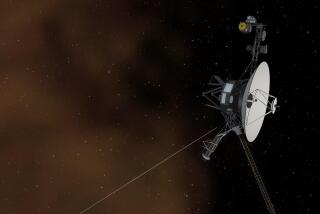NASA’s glitch fix leaves Hubble alive and clicking
It was a good news, bad news day for NASA on Thursday as space agency managers announced that they had successfully restarted the broken Hubble Space Telescope, but acknowledged that they won’t be ready to send a repair team to the 18-year-old instrument until May at the earliest.
After reactivating two cameras on Hubble, scientists beamed its first pictures to Earth since a glitch idled the telescope several weeks ago.
They released an image of a pair of interacting galaxies that appeared to form the number 10 -- a picture that inspired NASA officials to declare the telescope had scored a “perfect 10” as it got back to work.
The glitch occurred in Hubble’s 135-pound data-handling unit, which gathers and packages information from five main instruments for delivery to the ground. Engineers spent the last few weeks attempting to switch those tasks from the malfunctioning Side A of the unit to the redundant Side B.
The new pictures were testimony to their success. The images were made with the scope’s Wide-Field Planetary Camera and the Advanced Camera for Surveys. NASA said it hoped to have the other instruments operating in the next few days.
There was no certainty the switch to Side B would work. That unit had sat idle in space for 18 years while its brother did all the work. But now that it’s operating, said Hubble manager Preston Burch of NASA’s Goddard Space Flight Center in Greenbelt, Md., he feels “very confident” it will continue to work in the coming weeks.
NASA also announced Thursday that a repair mission to Hubble would be delayed once again. Before the data-handling unit broke, a team was to depart for the telescope Oct. 14 to replace faulty gyroscopes and worn batteries. NASA said the mission would be delayed until at least February while engineers took a new data-handling unit out of storage and prepared it for launch.
That unit, it turned out, wasn’t operable. It had been partly disassembled. When it was put back together, it “didn’t handle the commands properly,” Burch said during a news briefing at NASA headquarters in Washington.
Troubleshooting those problems will make it impossible to deliver the new data-handling unit to Kennedy Space Center in Florida before April, Burch said.
“We don’t want to take any chance of bringing a box up there that isn’t going to work 100% of the time,” he said.
NASA officials said the ailing telescope should be able to survive the extra wait time without breaking down again. Three of Hubble’s gyroscopes, which keep it properly oriented, have failed, leaving it to operate on two. If necessary, NASA said, it could work with just one.
After 18 years, Hubble’s batteries are operating at half-capacity.
“They are long past their design lifetime,” Burch said. “The prudent thing to do is replace them. But we’ll be fine for the next several months.”
The repair mission, whenever it happens, will be the last for Hubble. NASA had not even planned to make this one but was forced into it by Congress after a public outcry in support of the telescope.
--
More to Read
Sign up for Essential California
The most important California stories and recommendations in your inbox every morning.
You may occasionally receive promotional content from the Los Angeles Times.










